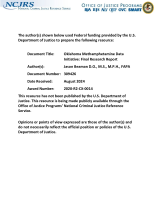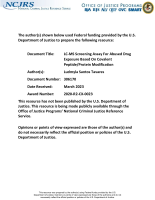Methamphetamine
Oklahoma Methamphetamine Data Initiative: Final Research Report
Date Published
July 2024
Agencies
NIJ-Sponsored
The Low-Down on Methamphetamine Isomers: Prevalence and Pharmacology in Humans
15PNIJ-23-GG-04216-MUMU
Open
Funding First Awarded
2023
$1,042,225
LC-MS Screening Assay For Abused Drug Exposure Based On Covalent Peptide/Protein Modification
Date Published
2022
Agencies
NIJ-Sponsored
Coupling Gas Chromatography (GC) and Vacuum Ultraviolet (VUV) Spectroscopy for Forensic Applications
Date Published
January 2021
Agencies
NIJ-Sponsored
Drug Use Impact on Native People in Minnesota
Event Dates
–
Eastern
Location
Online
Event Type
Webinar
Registration Status
Not Required





